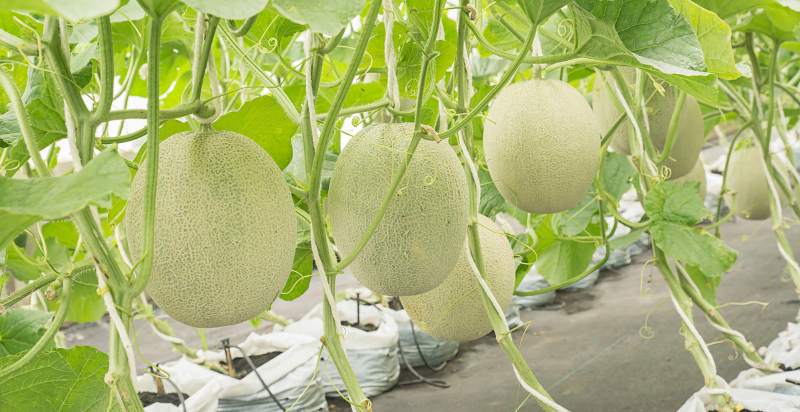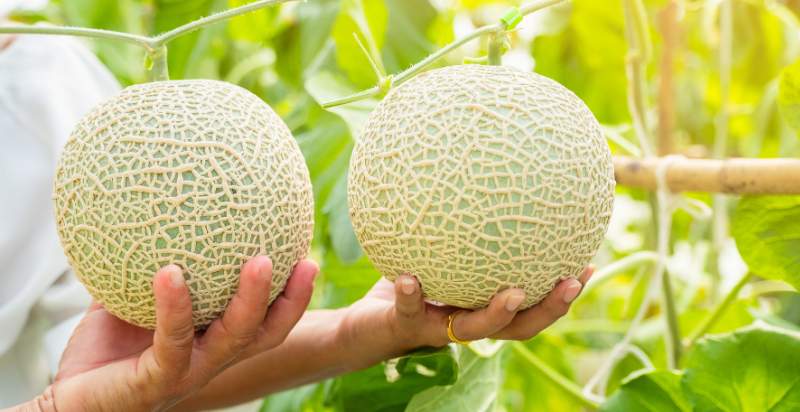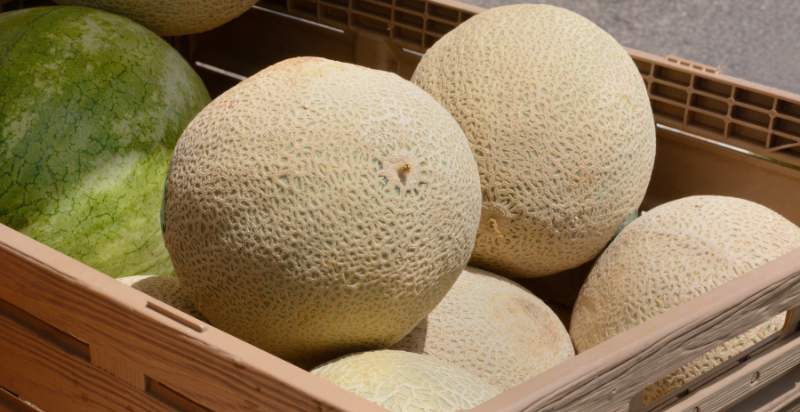Cantaloupe is a sweet, juicy melon belonging to the genus Cucumis and the species sativus. It is one of the most popular summer fruits worldwide and can be found in grocery stores year-round. Cantaloupes are widely known for their bright orange color, fragrant aroma, and high nutritional content. This article will discuss everything there is to know about cantaloupes, including their history, nutrition benefits, uses in cooking, and more!
What is Cantaloupe?
Cantaloupe is a spherical or oval-shaped melon with a thick, netted rind. Inside, it is filled with bright orange flesh that can range from slightly sweet to very sweet, depending on the variety. It has a distinct aroma and flavor that many people find irresistible. Cantaloupe also contains numerous vitamins and minerals, including vitamins A, C, potassium, magnesium, and folate.
History of Cantaloupe:
The origin of cantaloupes dates back thousands of years to India, where farmers cultivated them in ancient times. They spread to other parts of Asia and eventually Europe during the Middle Ages. Italian botanist Pietro Andrea Mattioli made the first recorded mention of cantaloupes in 1544.
Types of Cantaloupe:
There are wide different varieties of cantaloupes available today, some of which include:
- Honeydew – This type has a sweet flavor and smooth skin.
- Galia – A hybrid variety with a light green rind and orange flesh.
- Charentais – An heirloom variety with a thin rind and sweet, aromatic flesh.
- Crenshaw – An oval-shaped melon with yellowish-green flesh.
Nutritional Benefits of Cantaloupe:
Cantaloupes are a low-calorie, nutrient-dense fruit, making them an excellent addition to any diet. Not only do they provide essential vitamins and minerals, but they also contain beneficial plant compounds that may help reduce inflammation and promote good health.
One cup (160 grams) of cantaloupe contains the following nutrients (1):
- Calories: 54
- Protein: 1 gram
- Carbs: 14 grams
- Fiber: 1 gram
- Vitamin A: 53% of the RDI
- Vitamin C: 94% of the RDI
- Magnesium: 9% of the RDI
- Potassium: 10% of the RDI
Cantaloupe offers various benefits, including antioxidants and promoting good eye health. It also reduces inflammation, improves digestion, and boosts immunity. Here are some additional nutritional benefits of cantaloupe.
- Antioxidants: Cantaloupes are high in powerful antioxidants like vitamins A and C, as well as beta-carotene, lutein, and zeaxanthin. These compounds help protect the body from free radical damage, which can lead to chronic disease.
- Eye Health: The antioxidants in cantaloupe may also benefit eye health. Lutein and zeaxanthin are especially beneficial for maintaining healthy eyesight and reducing the risk of macular degeneration with age.
- Inflammation: Cantaloupes could be beneficial for reducing inflammation due to their high levels of vitamin C and chlorogenic acid, a plant compound found in cantaloupe skin. Both of these substances have been linked to anti-inflammatory benefits that may reduce the risk of certain diseases.
- Digestion: The fiber in cantaloupe is beneficial for digestion. Fiber helps to add bulk to stools and increases the speed of food moving through the digestive tract, which can help relieve constipation.
- Immunity: Vitamin C is essential for a healthy immune system. It helps fight off infection and boost immunity. Cantaloupes are an excellent source of this vitamin, making them beneficial for protecting against colds and other illnesses.
Cantaloupes offer a variety of health benefits due to their nutrient content. If you’re looking for a delicious way to improve your health, adding cantaloupe to your diet may be just what you need!
Uses of Cantaloupe:
Cantaloupe is a delicious and refreshing fruit that can be enjoyed in various ways. It can be eaten raw, juiced, blended into smoothies, or dried for an easy snack. It also has numerous health benefits due to its high levels of vitamins and antioxidants.
One of the most popular uses for cantaloupe is as an ingredient in salads. Its naturally sweet flavor compliments other ingredients, like crunchy lettuce and bits of crisp bacon. Cantaloupe can also make salsa and chutneys, perfect accompaniments to grilled meats or fish dishes.
Beyond the kitchen, cantaloupe is also great for skin care and beauty treatments. The fruit’s high levels of vitamins and antioxidants can help protect skin from free radical damage, leaving it feeling nourished and hydrated. Cantaloupe pulp can be blended into a face mask that can be left on for 15-20 minutes before being washed off with warm water.
Cantaloupe is also a great ingredient for juices, shakes, and smoothies. Its natural sweetness means it doesn’t need added sugars or sweeteners to make these drinks delicious. Adding cantaloupe to other fruits like strawberries or bananas will create smoothly blended beverages packed with nutrients that are perfect for breakfast or snacks.
In addition to its culinary and beauty uses, cantaloupe has also been found to have potential medicinal benefits. Its nutrients and antioxidants are believed to help reduce the risk of some cancers and can also help strengthen immunity. Cantaloupe is a great addition to any diet, providing a refreshing snack with numerous health benefits.
Overall, cantaloupe is an incredibly versatile fruit that can be used in various ways. Its sweet flavor and high levels of vitamins and antioxidants make it a great ingredient for salads, face masks, juices, smoothies, and more. In addition to its culinary uses, cantaloupe also has potential medicinal benefits. All these things combined make cantaloupe one of the most popular fruits around.

How to Plant Cantaloupe?
Cantaloupe is an incredibly refreshing and sweet fruit that can be enjoyed in various ways. Its unique flavor and bright orange flesh make it a favorite snack for kids and adults alike. Growing cantaloupe at home can be rewarding, but it does come with some challenges. Luckily, if you follow the instructions below, you should have success harvesting delicious cantaloupe from your garden:
Instructions
- Choose a sunny spot in your garden to plant your cantaloupe seeds. Cantaloupes need plenty of sunshine to grow successfully, so ensure your chosen location gets at least 8 hours of direct sun per day.
- Prepare the soil by loosening it up and adding a few inches of compost to the top. Cantaloupes need well-drained soil with plenty of organic matter for their roots to thrive.
- Plant your cantaloupe seeds about 1 inch deep, spaced 8-12 inches apart from each other. Water them gently and keep the soil damp until they germinate (generally within 10 days).
- Once your seedlings have sprouted, thin out the weaker ones so that only the strongest plants remain. This will give you better yields since the remaining plants can spread out more evenly and get more sunlight.
- Put mulch around the base of your plants to help retain moisture in the soil and reduce weeds. This will also help protect the roots from extreme temperatures and keep fruit off the soil, so it stays clean and disease-free.
- Water your cantaloupes regularly to keep the soil evenly moist but not soggy (about 1 inch per week). In hot weather, you may need to water more frequently.
- Once flowers appear, add a high-phosphorus fertilizer such as bone meal or fish emulsion to give them an extra boost and ensure healthy fruit production.
- Harvest your cantaloupe when they feel soft but still have some resistance when squeezed gently with your fingers – this usually takes about 3 weeks after flowering begins. Cut them off of the vine with a sharp knife.
These steps should help you get the most out of your cantaloupe crop. With some patience and proper care, you will soon be enjoying delicious home-grown melons.

How to Care for and Grow Cantaloupe?
Cantaloupe is an easy-to-grow, delicious, and nutritious fruit. With a little care and attention, you can enjoy the sweet flavor of homegrown cantaloupes all summer long.
When growing cantaloupes, choose a sunny location with well-drained soil. Cantaloupes need at least 6 hours of direct sunlight daily to produce ripe fruits. Consider adding organic matter, such as compost or manure, to the soil before planting your seeds or seedlings. When planting the seeds or seedlings, space them at least 3 feet apart so they have plenty of room to grow without overcrowding each other.
Once planted, water your cantaloupes regularly. They require 1-2 inches of water per week through rainfall or regular watering. You can also use a soaker hose to ensure the soil is evenly moist.
Mulching around your cantaloupe plants can help keep the soil moist and reduce weeds. A mulch layer of straw, hay, or grass clippings should be applied 2-3 inches deep over the topsoil and extend at least 18 inches from each plant.
Fertilizing your cantaloupes will ensure they get all the nutrients they need for proper growth and fruit production. A balanced fertilizer such as 10-10-10 or 8-8-8 should be applied to the soil twice during the growing season, once after planting, and again when the plants start producing fruit.
Finally, keep an eye out for pests and diseases. Common cantaloupe pests include squash bugs, aphids, whiteflies, cucumber beetles, and nematodes. Diseases such as Mosaic virus, powdery mildew, and anthracnose can also affect plants. If you notice any signs of pests or disease on your plants, treat them immediately before they spread throughout your garden.
With a little bit of patience and care, you can enjoy delicious homegrown cantaloupes all summer long.

Preventions from Pests and Diseases:
- Crop rotation – This helps prevent disease because it reduces the chance that disease-causing organisms can survive in the soil from one season to the next.
- Proper planting and spacing – Planting your cantaloupes at the proper spacing will ensure they get enough sunlight and air circulation, which can help prevent disease.
- Mulch around plants – Mulching around plants helps reduce weeds, retain moisture in the soil, and keep fruit off the soil, reducing chances of contamination with diseases or pests.
- Keep an eye out for pests – Regularly check for signs of pests such as aphids, squash bugs, cucumber beetles, whiteflies, or nematodes. If you spot any of these, treat the issue immediately before it spreads throughout your garden.
- Prune and deadhead plants – Pruning off excess foliage or deadheading flowers can help reduce the chances of pests and diseases from taking hold in your cantaloupe patch.
- Select disease-resistant varieties – When buying seedlings, look for varieties resistant to common diseases, such as powdery mildew and mosaic virus. This can help prevent problems in your garden.
By following these tips, you can help ensure that your cantaloupes produce a healthy crop all season long! Enjoying delicious home-grown melons is definitely worth the effort.

How to Harvest Cantaloupe?
When harvesting cantaloupes, they should be picked when they are ripe. To determine if a melon is ready, look for the following signs:
- The stem separating from the fruit – When a cantaloupe is ripe, it will easily separate from the fruit when it’s lightly tugged.
- Color of skin– If a cantaloupe’s skin has begun to turn yellow or orange and looks slightly wrinkled, it’s ready to be harvested.
- Aroma – Ripe cantaloupes will have a sweet aroma that can be detected before you pick them up.
Once you’ve determined that the cantaloupes are ripe, use a sharp knife or garden shears to cut their stem away. Be sure to attach a small stem so you can easily carry them without damaging them.
Cantaloupes should be stored in the refrigerator and eaten within a few days of harvesting. With proper care, they’ll remain fresh for up to two weeks!
Bonus Tip: If you plan on freezing your cantaloupe for later use, ensure it is ripe but firm. This will help ensure that your frozen melons have the best flavor and texture when thawed and enjoyed.
Bonus Tip: Keep an eye on the weather when harvesting cantaloupes. If heavy rain is forecasted, pick them early to avoid washing away all the deliciously sweet juices inside.

How to Store Cantaloupe?
Once you’ve harvested ripe cantaloupes, store them in the refrigerator for the best results. They’ll remain fresh for up to two weeks when stored properly.
If you have extra cantaloupe that won’t be eaten immediately, one of the easiest ways to preserve it is by freezing it. Slice or cube your melons and spread them on a baking tray in a single layer. Freeze them until solid and then transfer them to an airtight container or bag for storage. Frozen cantaloupes will stay good in the freezer for up to 6 months!
Cantaloupes can also be dried, canned, or juiced for longer-term storage of their flavor and nutrients. When using these methods, be sure to use a tried and true recipe to ensure safety.
By properly storing cantaloupes, you can enjoy this favorite summer fruit’s sweet taste and juicy texture all year long!

How to Use Cantaloupe in Day-to-Day Life?
Cantaloupe is an incredibly versatile fruit that can be eaten as a snack, added to smoothies, or used in salads and other dishes. It is high in vitamins A and C and contains plenty of fiber. Additionally, cantaloupe has anti-inflammatory properties and can help boost the immune system. Here are some ways you can incorporate cantaloupe into your day-to-day life:
- Use it as a snack – Cantaloupe slices make for a sweet, juicy snack packed with nutrients. Cut the melon into slices or cubes for a tasty treat any time of day.
- Add it to smoothies – Blend cantaloupe with other fruits, vegetables, and yogurt to make a delicious smoothie.
- Make a salad – Cantaloupe is the perfect addition to salads. Toss cubes of melon with greens, feta cheese, and olives for a Mediterranean-inspired dish.
- Use it in salsas – Blend cantaloupe chunks with cucumbers and tomatoes to create an easy salsa that’s full of flavor.
- Grill it – Slice cantaloupe into thick rounds before grilling for an added sweet flavor to any meal.
- Bake with it – Add cantaloupe in muffins or bread for a unique taste and texture experience.
- Enjoy it in smoothie bowls – Top your smoothie with cantaloupe slices or cubes for a refreshing breakfast.
- Try it in desserts – Cantaloupe makes for an interesting addition to desserts such as tarts, pies, cobblers, cakes, ice creams, and more.
No matter how you use cantaloupe in daily life, it’s sure to add an extra burst of flavor and nutrition to your meals.

Potential risks from lemongrass :
Consuming too much lemongrass can be dangerous, leading to various side effects. These include digestive upset, diarrhea, heartburn, and nausea. Lemongrass may also interact with medications for diabetes, high cholesterol, or NSAIDS (non-steroidal anti-inflammatory drugs). Additionally, pregnant women should avoid consuming excessive amounts of lemongrass due to its potential to cause contractions. Therefore, use caution when consuming this herb and speak to your doctor before adding it to your diet if you have any concerns.
Never consume large amounts of lemongrass at once, as it can be toxic in high doses. It is best to start small and increase slowly until the desired effect has been achieved. Additionally, it is important to ensure the lemongrass you are using is fresh and of good quality. Old or contaminated lemongrass can cause serious illness, so purchase it from a trusted source.
Overall, consuming small amounts of lemongrass in food or tea can provide some health benefits for most people. However, if taken in large doses, it can pose a risk to your health. Therefore, use caution when adding this herb to your diet, and speak with your doctor if you have any concerns.
Conclusion:
Cantaloupe is a delicious and nutrient-rich fruit that can be enjoyed throughout the year when stored properly. Whether you choose to freeze, dry, can, or juice it, cantaloupe is an incredibly versatile fruit that can be incorporated into many dishes for added flavor and nutrition. Additionally, lemongrass can be used as a herbal remedy providing certain benefits when consumed in small amounts.
However, use caution, as large doses of lemongrass may not be safe for everyone. You must speak with your doctor if you have any concerns before adding cantaloupe and lemongrass to your diet. With these tips in mind, enjoy the summary flavors of cantaloupe and lemongrass!
- Water Berries: Description, Flavor, Benefits, And Uses - June 18, 2024
- Everything You Wanted To Know About Sweetheart Cherries - June 17, 2024
- Indian Jujube: Description, Flavor, Benefits, And Uses - April 30, 2024

6 thoughts on “What is Cantaloupe? How to Plant, Grow, and Harvest Cantaloupe”
Comments are closed.